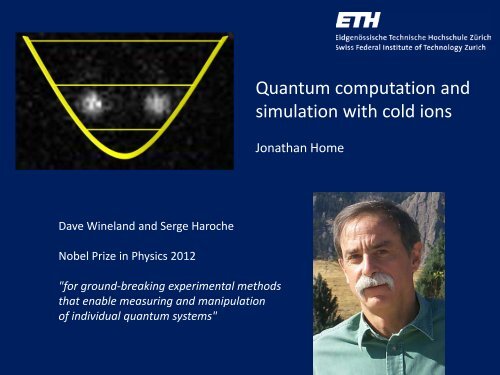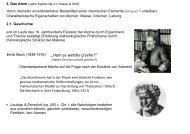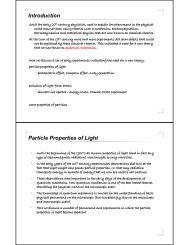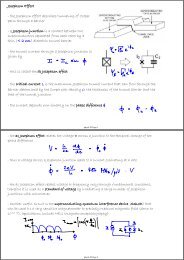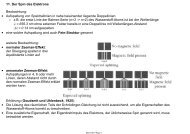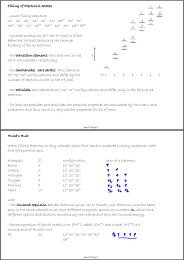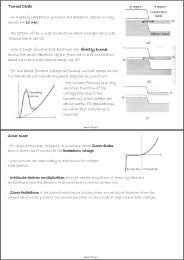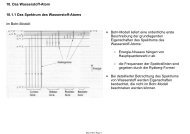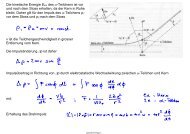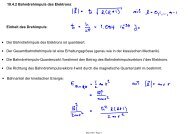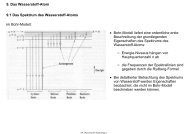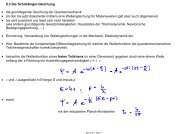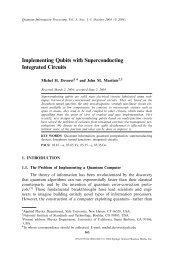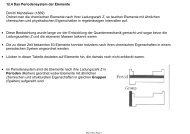slides - Quantum Device Lab
slides - Quantum Device Lab
slides - Quantum Device Lab
You also want an ePaper? Increase the reach of your titles
YUMPU automatically turns print PDFs into web optimized ePapers that Google loves.
<strong>Quantum</strong> computation and<br />
simulation with cold ions<br />
Jonathan Home<br />
Dave Wineland and Serge Haroche<br />
Nobel Prize in Physics 2012<br />
"for ground-breaking experimental methods<br />
that enable measuring and manipulation<br />
of individual quantum systems"
<strong>Quantum</strong> computation<br />
(Precision control of large-scale quantum mechanical systems)<br />
David Deutsch: Collection of two-state quantum systems (qubits)<br />
time<br />
Initialise<br />
qubit to<br />
single state<br />
Detect<br />
qubit state<br />
Large scale device:<br />
Operations which manipulate isolated qubits or pairs of qubits<br />
Transport information around processor/distribute entangled states<br />
Perform operations accurately enough to achieve fault-tolerant error-correction<br />
(reach arbitrary size system) – accuracy of 0.9999 required
Isolating single charged atoms<br />
Laplace‘s equation<br />
– no chance to trap with static fields<br />
Paul trap: Use a ponderomotive potential – change potential fast compared to speed of ion<br />
Time average - Effective potential energy which is minimal at minimum E
Traps – traditional style<br />
DC<br />
RF electrode<br />
RF<br />
Axial potential gives almost ideal harmonic behaviour<br />
n = 2<br />
n = 1<br />
n = 0
Ion traps at ETH Zurich<br />
RF<br />
RF ground<br />
DC<br />
RF<br />
DC<br />
RF<br />
RF<br />
RF ground
Storing a qubit in multi-level atoms<br />
40<br />
Ca + - fine structure 9<br />
Be + - hyperfine structure<br />
(16 Hyperfine states)
Choice of qubit levels<br />
Requirement: long decay time for upper level.
Storing qubits in an atom<br />
- phase coherence<br />
Problem: noise! – mainly from classical fields
Storing qubits in an atom<br />
Field-independent transitions<br />
F = 1<br />
119.645 Gauss<br />
1 GHz<br />
1207 MHz<br />
F = 2<br />
Time (seconds)<br />
Langer et al. PRL 95, 060502 (2005), >50 seconds Alcock et al. (2012)
Entanglement for protection<br />
Rejection of common-mode noise<br />
Now consider entangled state<br />
If noise is common mode, entangled states can have very long coherence times<br />
Haffner et al., Appl. Phys. B 81, 151-153 (2005)
Preparing the states of ions<br />
Optical pumping – state initialisation<br />
Use a dipole transition for speed<br />
Example: calcium<br />
Calcium: scatter around 3 photons to prepare
Reading out the quantum state<br />
Imaging<br />
system<br />
Photon scattered every 7 ns<br />
BUT<br />
we only collect a small fraction of these<br />
Need to scatter 1000 photons to detect atom
Measurement – experiment sequence<br />
Initialise<br />
Manipulate<br />
Detect<br />
How many photons?<br />
Statistics: repeat the experiment many (1000) times<br />
Number of photons = 8, 4, 2, 0, 0, 1, 5, 0, 0, 8 ….
Single shot measurement<br />
“Realization of quantum error-correction“, Chiaverini et al., Nature 432, 602, (2004)<br />
Target<br />
Ancilla<br />
Classical processing<br />
“If you get 1, 0, do Y, else do X“<br />
Ancilla<br />
Measurement: “8 counts, this qubit is 1!“<br />
Accuracy of 0.9999 achieved in 150 microseconds<br />
Myerson et al. Phys. Rev. Lett. 100, 200502, (2008)
<strong>Quantum</strong> jumps of a single atom<br />
Bergquist et al. PRL 57, 14, (1986)<br />
281.5 nm laser on resonance<br />
time
Manipulating single qubits<br />
Laser-driven,<br />
quadrupole<br />
Counts<br />
Resonant microwaves,<br />
hyperfine<br />
Raman transition,<br />
hyperfine
Addressing individual qubits<br />
Intensity addressing<br />
Frequency addressing<br />
Shine laser beam at one ion in string<br />
Image: Roee Ozeri<br />
2-4 μm<br />
Separate ions by a distance much larger than<br />
laser beam size<br />
240 μm
Multiple qubits: interactions
Multiple ions: coupled harmonic oscillators<br />
Expand about equilibrium – equation of motion<br />
Independent oscillators<br />
- shared motion
The original thought<br />
Cirac and Zoller, PRL (1995)<br />
“The collective oscillator is a quantum bus“
The forced harmonic oscillator<br />
Classical forced oscillator<br />
“returns“ after<br />
Radius of loop
Forced quantum oscillators<br />
Transient excitation, phase acquired
State-dependent excitation<br />
Entangled spin-motion state<br />
“Schrodinger‘s cat“
Two-qubit gate, state-dependent<br />
excitation<br />
Force is out of phase; excite Stretch mode<br />
Force is in-phase; excite COM mode
Examples: quantum computing<br />
Choose the duration and power:<br />
Universal two-qubit ion trap quantum processor: Hanneke et al. Nature Physics 6, 13-16 (2010)
Laser-driven multi-qubit gates<br />
basis, polarisation standing wave<br />
Leibfried et al. Nature 422, 412-415 (2003)<br />
basis, interference effect<br />
F<br />
F<br />
F<br />
F
State and entanglement characterisation<br />
Detect<br />
8, 6, 7, 4, 9, 0, 0, 1, 1, 6, 1, 9, 0, 0…<br />
5, 4, 3,11, 4, 1, 0, 0, 1, 8, 0, 8, 1, 0…<br />
Entanglement – correlations…<br />
Choose 12 different settings of<br />
Qubits in the<br />
same state<br />
Reconstruct density matrix<br />
Qubits in<br />
different states<br />
F = 0.993 (Innsbruck)<br />
Benhelm et al. Nat. Phys 4, 463(2008)
<strong>Quantum</strong> simulation with trapped-ions<br />
Creation of “condensed-matter“ Hamiltonians with long-range interactions<br />
(Friedenauer et al. Nat. Phys 4, 757-761 (2008), Kim et al. Nature 465, 7298 (2010))<br />
Go to limit of large motional detuning<br />
(very little entanglement between spin and motion)
Dealing with large numbers of ions<br />
Technical requirement<br />
Spectral mode addressing<br />
Many ions<br />
Simultaneous laser addressing<br />
Limitation<br />
Mode density increases<br />
Heating rates proportional to N<br />
Ions take up space (separation > 2 micron)<br />
Laser beams are finite-size
Entanglement of up to 14 ions<br />
Monz et al., PRL 106, 130506 (2011)<br />
High contrast – 3 ions<br />
Reduced contrast – 14 ions
<strong>Quantum</strong> simulations in ion strings<br />
(up to 18 ions Islam et al. arxiv:1210.0142)
Isolate small numbers of ions<br />
Wineland et al. J. Res. Nat. Inst. St. Tech, (1998)<br />
“coolant“ ion<br />
Technological challenge – large numbers of electrodes, many control regions
Distributing entanglement: probabilistic<br />
"Click"<br />
50/50 beamsplitter<br />
"Click"<br />
Entangled ions separated by 1m ( Moehring et al. Nature 449, 68 (2008) )
Transport with ions<br />
240 μm<br />
Internal quantum states of ions unaffected by transport<br />
Motional states are affected – can be re-initialised<br />
Total transport distance = 1 mm<br />
Move: 20 us, Separate 340 us, 0.5 quanta/separation<br />
Zone A<br />
Separation<br />
Zone B<br />
10 ms J .P. Home et al. Science 325, 1228 (2010)
Trapping ions on a chip<br />
For microfabrication purposes, desirable to deposit trap structures on a surface<br />
(Chiaverini et al., Quant. Inf. & Computation (2005), Seidelin et al. PRL 96, 253003 (2006))<br />
end view of<br />
quadrupole<br />
electrodes<br />
Field lines:<br />
trap axis<br />
RF electrodes<br />
Control electrodes<br />
Challenges: shallow trap depth (100 meV)<br />
charging of electrodes<br />
Opportunities: high gradients
Transporting ions on a (complicated) chip<br />
J. Amini et al. New. J. Phys 12, 033031 (2010)
Integrated components 1<br />
Vandevender et al. PRL 105, 023001 (2010)
Integrated components<br />
eg. <strong>Quantum</strong> control using microwaves – removes the need for high-power lasers<br />
Gradients – produce<br />
state-dependent<br />
potentials through<br />
Zeeman shifts<br />
Single-qubit gate<br />
2-qubit gate<br />
C. Ospelkaus et al. Nature 182, 476 (2011)
Trapped-ions and optical clocks<br />
e.g. Rosenband et al., Science 319, 1808 (2008)<br />
Frequency standards<br />
Aluminium ion<br />
Laser<br />
167 nm<br />
267 nm<br />
Require very stable ion transition<br />
Has a very stable transition<br />
BUT 167 nm is vacuum UV
Atomic clocks – quantum logic readout<br />
Aluminium “Clock” ion:<br />
Shared motion<br />
Beryllium<br />
Cooling and readout ion<br />
“Allowed” (scatter<br />
lots of photons)<br />
Most accurate and precise frequency standards – 8e-18 fractional uncertainty<br />
(Chou et al. PRL 104, 070802 (2010))
Trapped-ion summary<br />
Have achieved quantum control<br />
of up to N ions<br />
Have demonstrated all basic components required<br />
to create large scale entangled states<br />
Algorithms & gates<br />
include Dense-coding, error-correction,<br />
Toffoli, Teleportation, Entanglement purification<br />
Entanglment swapping<br />
Working on:<br />
Higher precision<br />
New manipulation methods<br />
Scaling to many ions


